belt MERCEDES-BENZ M-Class 2012 W166 Owner's Guide
[x] Cancel search | Manufacturer: MERCEDES-BENZ, Model Year: 2012, Model line: M-Class, Model: MERCEDES-BENZ M-Class 2012 W166Pages: 396, PDF Size: 14.48 MB
Page 55 of 396
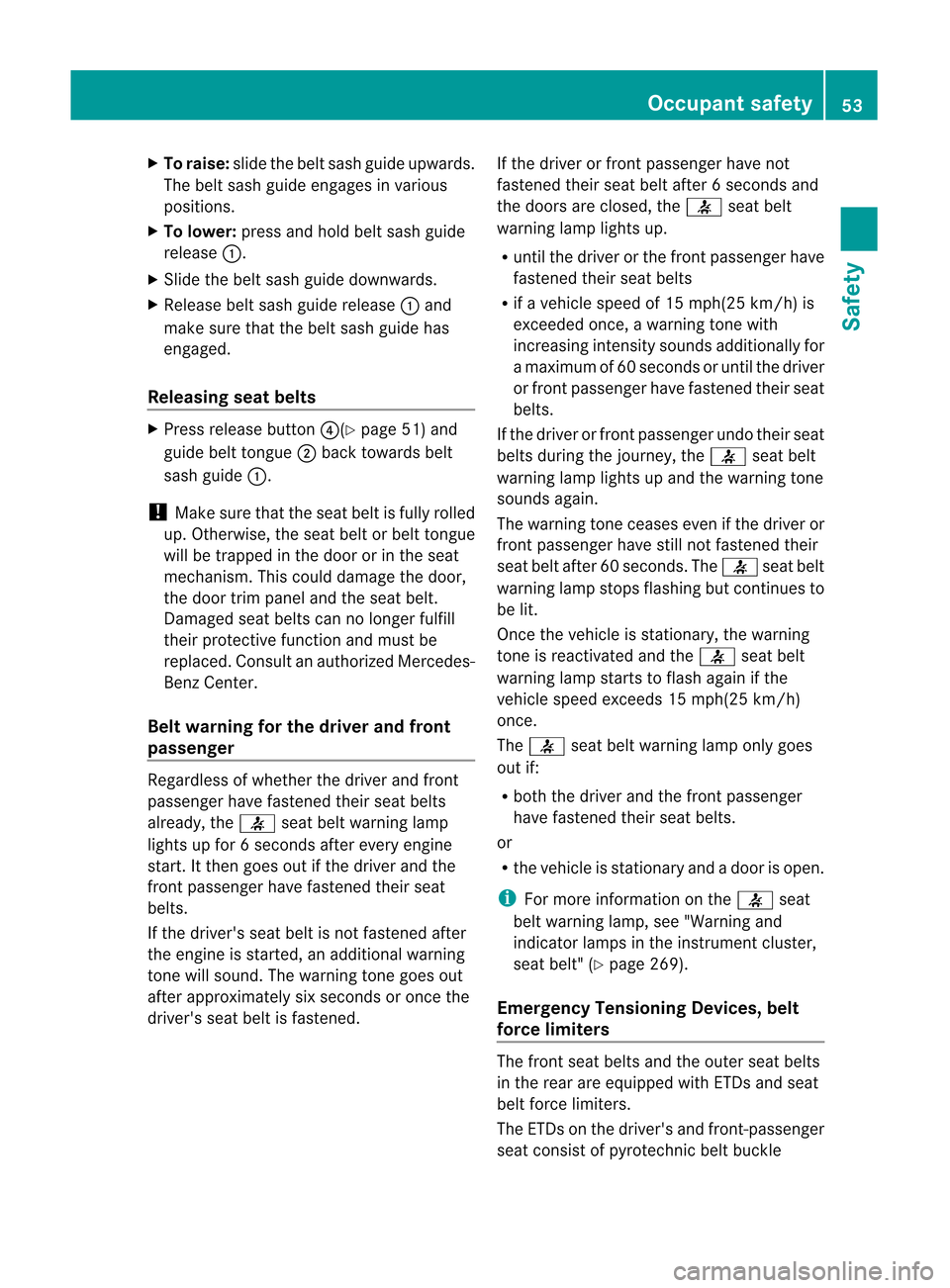
X
To rais e:slid ethe beltsa sh guideup wa rds .
The beltsa sh guide eng ages invario us
po sitio ns.
X To lowe r:pre ssand holdbe ltsa sh guide
rel ease :.
X Sli de the beltsa sh guide do wnw ards.
X Re leas ebe ltsa sh guide rel ease : and
ma kesure tha tthe belt sash guide has
engaged.
Releasing seatbelts X
Press release button?(Ypage51)and
guide belttongue ;back towards belt
sash guide :.
! Make surethattheseat beltisfully rolled
up. Otherwise, theseat beltorbelt tongue
will betrapped inthe door orinthe seat
mechanism. Thiscould damage thedoor,
the door trimpanel andtheseat belt.
Damaged seatbelts cannolonger fulfill
their protect ivefunct ionand must be
replaced. Consultanauthorized Mercedes-
Benz Center.
Belt warning forthe driver andfront
passenger Regardl
essofwhether thedriver andfront
passenger havefastened theirseatbelts
already ,the 7 seatbeltwarning lamp
lights upfor 6secon dsafter every engine
start .It then goes outifthe driver andthe
fron tpasse nger have fastened their seat
belt s.
If th edriv er'sseat beltisno tfast ened after
th een gin eis start ed, anaddit ionalwarn ing
to ne will soun d.The warn ingtone goes out
aft erappro ximatelysix sec onds oronce the
driv er'sseat beltisfast ened. If
th edriv eror fron tpasse nger have not
fast ened their seat beltafter6s econ dsand
the doors areclosed, the7 seatbelt
warning lamplights up.
R until thedriver orthe fron tpasse nger have
fast ened their seat belts
R ifaveh icle spee dof 15 mph (25km/h)is
ex cee ded once, awarn ingtone with
inc reas ingintensitysoun dsaddit ionally for
a max imum of60 sec onds orunt ilth edriv er
or fron tp asse nger have fastened their seat
belt s.
If th edriv eror fron tpasse ngerundo their seat
belt sdurin gth ejo urn ey, the7 seatbelt
warn inglamp lightsup and thewarn ingtone
soun dsagain .
The warn ingtone ceas eseve nifthe driver or
front passenger havestillnotfastened their
seat beltafter 60seconds. The7 seatbelt
warning lampstops flashing butcont inues to
be lit.
Once thevehicle isstationary, thewarning
tone isreactivated andthe7 seatbelt
warning lampstarts toflash again ifthe
vehicle speedexceeds 15mph(25 km/h)
once.
The 7 seatbeltwarning lamponlygoes
out if:
R both thedriver andthefront passenger
have fastened theirseatbelts.
or
R the vehicle isstationary andadoor isopen. i
For
more information onthe 7 seat
belt warning lamp,see"Warning and
indicator lampsinthe instrumen tcluster,
seat belt" (Ypage 269).
Emergency TensioningDevices,belt
force limiters The
front seatbelts andtheouter seatbelts
in the rear areequipp edwith ETDs andseat
belt force limiters.
The ETDs onthe driver's andfront -passenger
seat consist ofpyrotechnic beltbuckle Occ
upantsafety
53Safety Z
Page 56 of 396
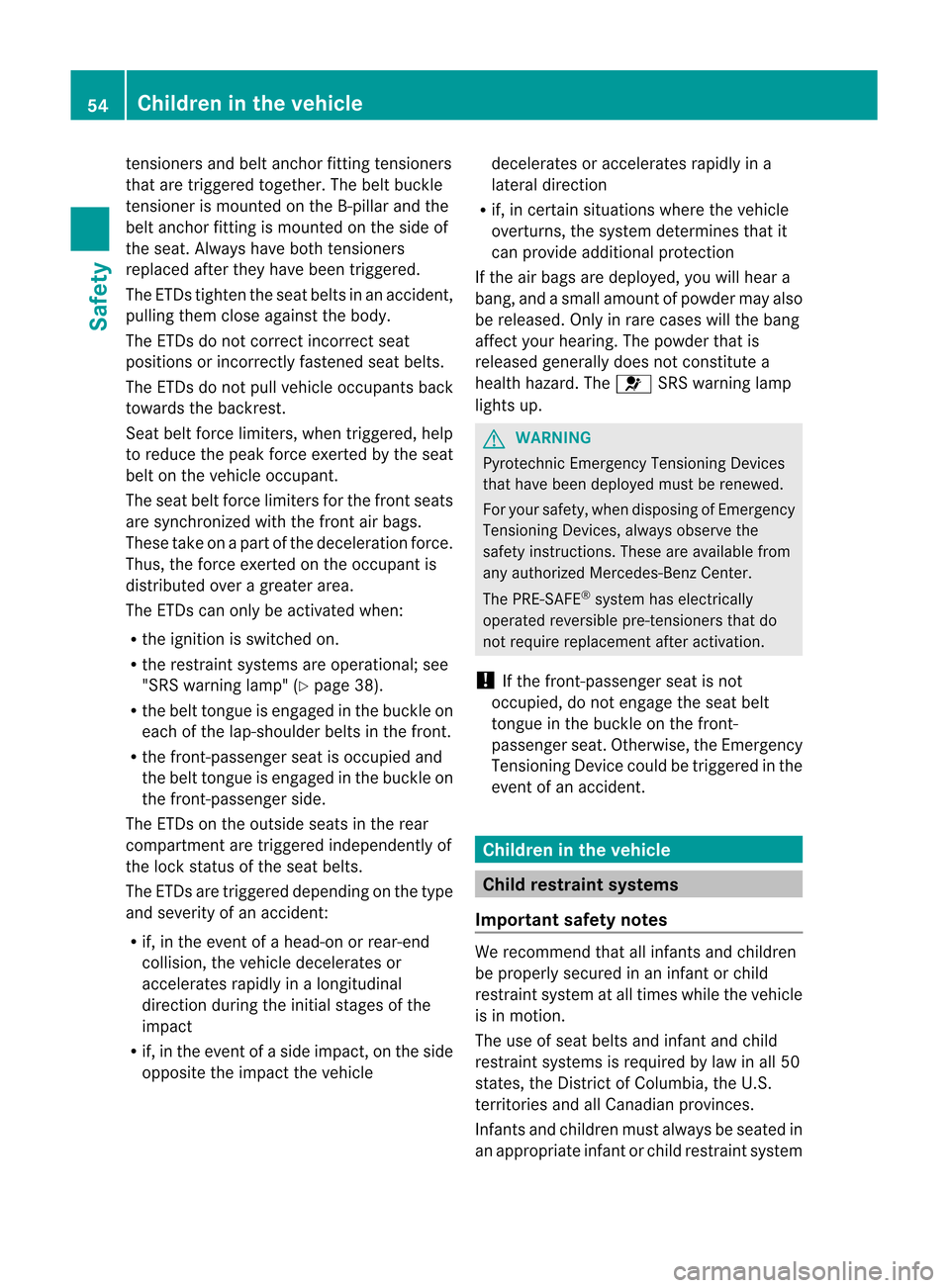
tens
ioners andbeltanc horfitting tension ers
that aretriggere dtog eth er. The belt buck le
ten sion erismoun tedonthe B-pillar andthe
belt anchor fittin gis moun tedonthe side of
the seat .Always havebothtension ers
replaced aftertheyhave been trigger ed.
The ETDstight enthe seat belts inan acciden t,
pulling themclose against thebody.
The ETDsdo not corr ectincor rectseat
position sor incor rectlyfasten edseat belts.
The ETDsdo not pull vehicle occupan tsback
towards thebackr est.
Seat beltforcelimiters, whentrigger ed,help
to reduce thepeak forceexerte dby the seat
be lton the vehicleoccu pant.
The seatbelt forc elimiters forthe fron tseats
are synchr onizedwith thefron tairbags.
These takeon apart ofthe decele ration force.
Thus, theforce exer tedonthe occupant is
dist ribut edover agreat erarea.
The ETDscan only beact ivat edwhen:
R the ignit ionisswitc hedon.
R the rest raint systems areoperat ional;see
"SRS warnin glamp" (Ypage 38).
R the belt tongue iseng aged inthe buck leon
each ofthe lap-sh oulder beltsinthe front.
R the front-pass engerseat isocc upied and
the belt tongue iseng aged inthe buck leon
the front-pass engerside.
The ETDson the outs ideseat sin the rear
com partmen tare triggere dindep endently of
the lock status ofthe seat belts.
The ETDs aretriggere ddepe nding onthe type
and severi tyof an accide nt:
R if, inthe event ofahea d-on orrear-end
colli sion, thevehicl edecel erates or
accele ratesrapidlyinalongi tudina l
dire ction duringthe initia lstag esofthe
im pact
R if,in the eventofaside impact, onthe side
op posite the impact the vehicle de
cel era tes oracc elera tes rapidlyin a
la tera ldi rec tion
R if,in cer tains ituat ions where thevehic le
over turns, the syst emdete rmin esthat it
can prov ideadditio nalprot ection
If the airbags aredeployed, youwillhear a
bang, andasmall amoun tofpowder mayalso
be released. Onlyinrare cases willthebang
affect yourhearing. Thepowder thatis
released generally doesnotconst itutea
health hazard. The6 SRSwarning lamp
lights up. G
WARNIN
G Pyrotechn
icEmergen cyTensionin gDevices
that have been deployed mustberenewed.
For your safety, whendisposing ofEmergen cy
Tensionin gDevices, alwaysobserve the
safety instructions. Theseareavailab lefrom
any authorized Mercedes-B enzCenter.
The PRE-S AFE®
system haselectric ally
operated reversible pre-tensioners thatdo
not require replacement afteractivation .
! Ifthe front -passenger seatisnot
occupied, donot engage theseat belt
ton gue inthe buckle onthe front -
passenger seat.Otherwise, theEmergen cy
Tensionin gDevice couldbetriggered inthe
event ofan accident . Children
inthe vehicle Child
restraintsystems
Import antsafety notes We
recomm endthat allinfant sand children
be properly securedinan infant orchild
restr aintsystem atall times whilethevehicle
is in motion .
The useofseat belts andinfant andchild
restr aintsystems isrequired bylaw inall 50
states, theDistr ictofColumbia ,the U.S.
territ ories andallCanadia nprovinces.
Infants andchild renmust alwaysbe seated in
an app ropria teinfant orchild restrai ntsystem 54
Chil
dren inthe vehi cleSafety
Page 57 of 396
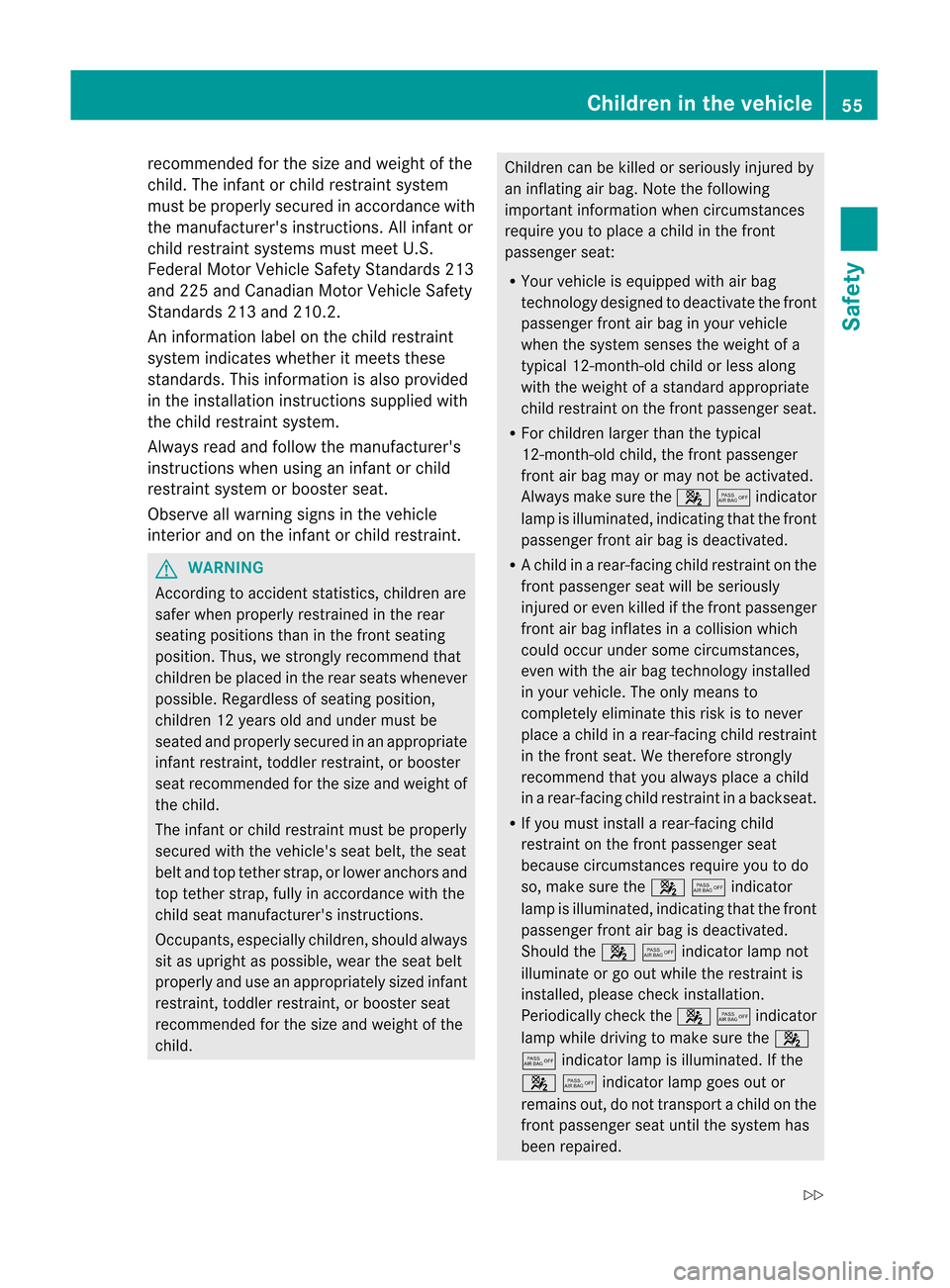
recommende
dfor the size andweight ofthe
child .The infant orchild restraint system
must beproperly securedinaccordance with
the manufacturer's instructions.Allinfant or
child restraint systemsmustmeet U.S.
Federal MotorVehicle SafetyStandards 213
and 225 andCanadia nMotor Vehicle Safety
Stan dards 213and210. 2.
An inform ationlabelonthe child restraint
system indicates whetheritmeets these
standards. Thisinform ationisalso provided
in the installation instructions supplied with
the child restraintsystem.
Always readandfollow themanufacturer 's
instr uctions whenusinganinfant orchild
restr aintsystem orbooster seat.
Observe allwarning signsinthe vehicle
inter iorand onthe infant orchild restraint. G
WARNIN
G Acc
ording toaccident statistics,children are
safer when properly restrained inthe rear
seating positions thaninthe front seating
position. Thus,westron glyrecommen dthat
children beplaced inthe rear seats whenever
possible. Regardless ofseating position,
children 12years oldand under mustbe
seated andproperly securedinan appropriate
infant restraint ,toddler restraint ,or booster
seat recommen dedforthe size andweight of
the child.
The infant orchild restraint mustbeproperly
secured withthevehicle's seatbelt, theseat
belt andtopteth erstrap, orlower anchors and
top teth erstrap, fullyinaccordanc ewith the
child seatmanufacturer 'sinstr uctions.
Occupant s,especially children,shouldalways
sit asupright aspossible, weartheseat belt
properly anduseanappropriately sizedinfant
restraint ,toddler restraint ,or booster seat
recommen dedforthe size andweight ofthe
child. Children
canbekilled orseriously injuredby
an inflating airbag. Note thefollowing
important informationwhen circumst ances
require youtoplace achild inthe front
passenger seat:
R Your vehicle isequipped withairbag
techn ology designed todeactivate thefront
passenger frontairbag inyour vehicle
when thesystem sensestheweight ofa
typical 12-mont h-old childorless along
with theweight ofastandard appropriate
child restraint onthe front passenger seat.
R For children largerthanthetypical
12- mont h-old child, thefront passenger
front airbag may ormay notbeactivated.
Always makesurethe45indicat or
lamp isilluminat ed,indic atingthat thefront
passen gerfrontair bag isdeact ivated.
R Ac hild inarear-facing childrestraint onthe
front passenger seatwillbeseriously
injured oreven killed ifthe front passenger
front airbag inflates inacollision which
could occur under somecircumstan ces,
even withtheairbag techn ology installed
in your vehicle. Theonly means to
completely eliminatethisriskisto never
place achild inarear-facing childrestraint
in the front seat. Wetherefore strongly
recommen dthat youalwa ysplace achild
in arear-facing childrestraint inabackseat.
R Ifyou must install arear-facing child
restraint onthe front passenger seat
because circumstan cesrequire youtodo
so, make surethe45indic ator
lamp isilluminat ed,indic atingthat thefront
passen gerfrontair bag isdeact ivated.
Should the45indic atorlamp not
illuminat eor go out while therest raint is
inst alled, please checkinsta llati on.
Pe rio dical lyche ckthe 45indicat or
lamp while drivingto make surethe4
5 indicatorlamp isilluminat ed.Ifthe
45indic atorlamp goesoutor
remain sout, donot transpo rtachild onthe
fro ntpassen gerseat untilthe syst emhas
been repaire d. Childr
eninthevehicle
55Safety
Z
Page 58 of 396
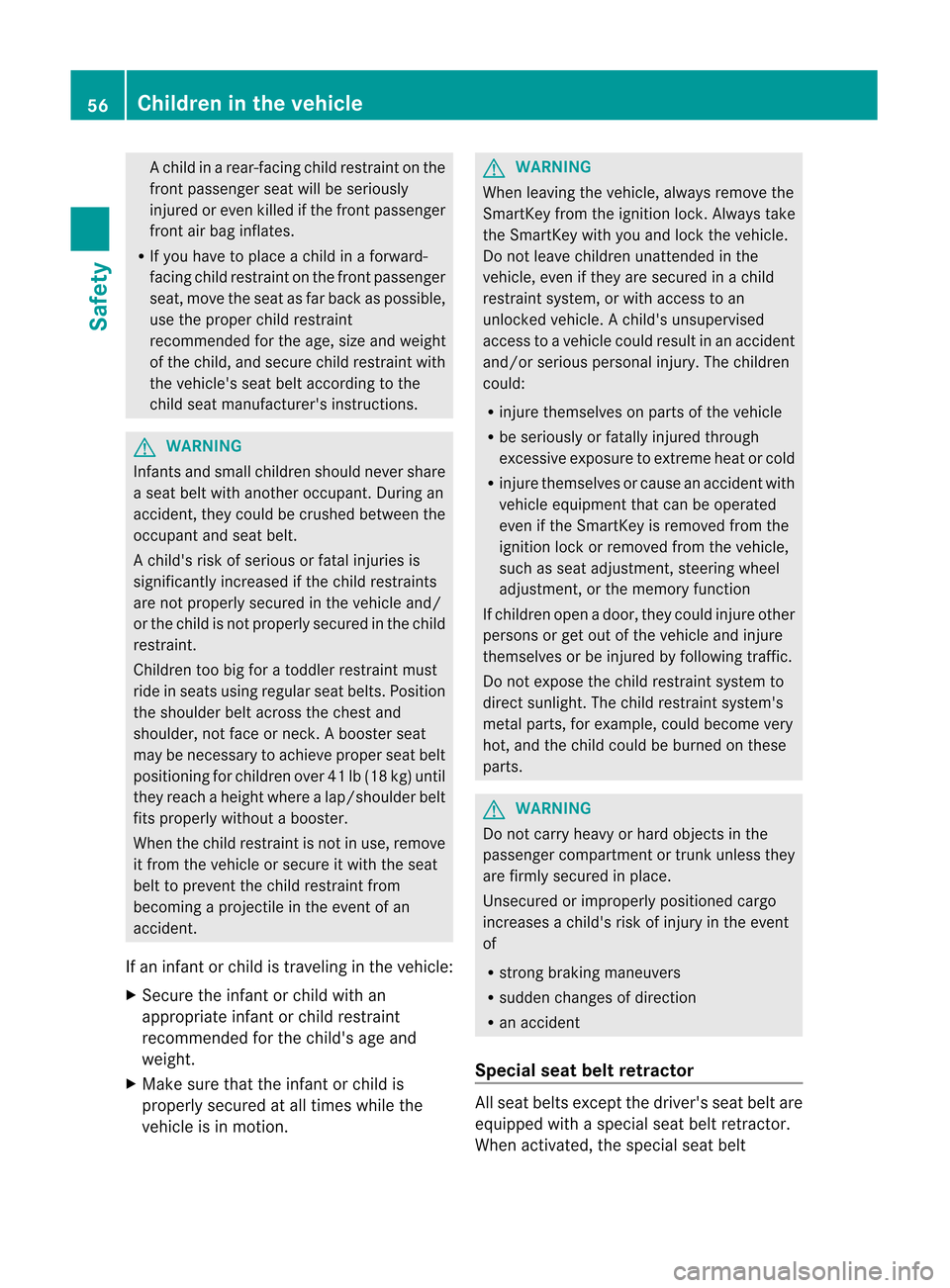
Ac
hild inarear-facing childrestraint onthe
front passenger seatwillbeseriously
injured oreven killed ifthe front passenger
front airbag inflates.
R Ifyou have toplace achild inaforward-
facing childrestraint onthe front passenger
seat, move theseat asfar back aspossible,
use theproper childrestraint
recommen dedforthe age, sizeandweight
of the child, andsecure childrestraint with
the vehicle's seatbeltaccording tothe
child seatmanufacturer's instructions. G
WARNING Infant
sand small children shouldnevershare
a seat beltwith another occupant. Duringan
accident, theycould becrushed between the
occupant andseat belt.
Ac hild's riskofserious orfatal injuries is
significantly increasedifthe child restraint s
are not properly securedinthe vehicle and/
or the child isnot properly securedinthe child
restraint .
Children toobigforatoddler restraint must
ride inseats usingregular seatbelts. Position
the shoulder beltacross thechest and
shoulder, notface orneck .Abooster seat
may benecessary toachieve properseatbelt
positioning forchildren over41lb(18 kg)until
they reach aheight wherealap/shoulder belt
fits properly withoutabooster.
When thechild restraint isnot inuse, remove
it from thevehicle orsecure itwith theseat
belt toprevent thechild restraint from
becoming aproject ileinthe event ofan
accident .
If an infant orchild istraveling inthe vehicle:
X Secure theinfant orchild withan
appropriate infantorchild restraint
recommen dedforthe child's ageand
weight.
X Make surethattheinfant orchild is
properly securedatall times whilethe
vehicle isin motion . G
WARNING When
leaving thevehicle, alwaysremove the
Smart Keyfrom theignition lock.Always take
the Smart Keywith youand lock thevehicle.
Do not leave children unattendedinthe
vehicle, evenifthey aresecured inachild
restraint system,orwith access toan
unlocked vehicle.Achild's unsupervised
access toavehicle couldresult inan accident
and/or serious personal injury.Thechildren
could:
R injure themselves onparts ofthe vehicle
R be seriously orfatally injured through
excessive exposuretoextrem eheat orcold
R injure themselves orcause anaccident with
vehicle equipment thatcanbeoperated
even ifthe SmartKey isremoved fromthe
ignition lockorremoved fromthevehicle,
such asseat adjustment ,steering wheel
adjustment ,or the memory function
If children openadoor, theycould injure other
persons orget out ofthe vehicle andinjure
themselves orbe injured byfollowing traffic.
Do not expose thechild restraint systemto
direct sunlight. Thechild restraint system's
metal parts, forexample, couldbecome very
hot, andthechild could beburned onthese
parts. G
WARNING Do
not carry heavy orhard object sin the
passenger compartmen tortrunk unles sthey
are firmly secure din pla ce.
Unsecured orimprop erlypositioned cargo
increase sa child 'srisk ofinjury inthe event
of
R strong braking maneuvers
R sudd enchanges ofdirectio n
R an accide nt
Spec ialseat beltretr act or All
seat beltsexc ept thed river's seatbeltare
equ ipped with aspeci alseat beltretrac tor.
When activated, thespecial seatbelt 56
Childr
eninthevehicleSafety
Page 59 of 396
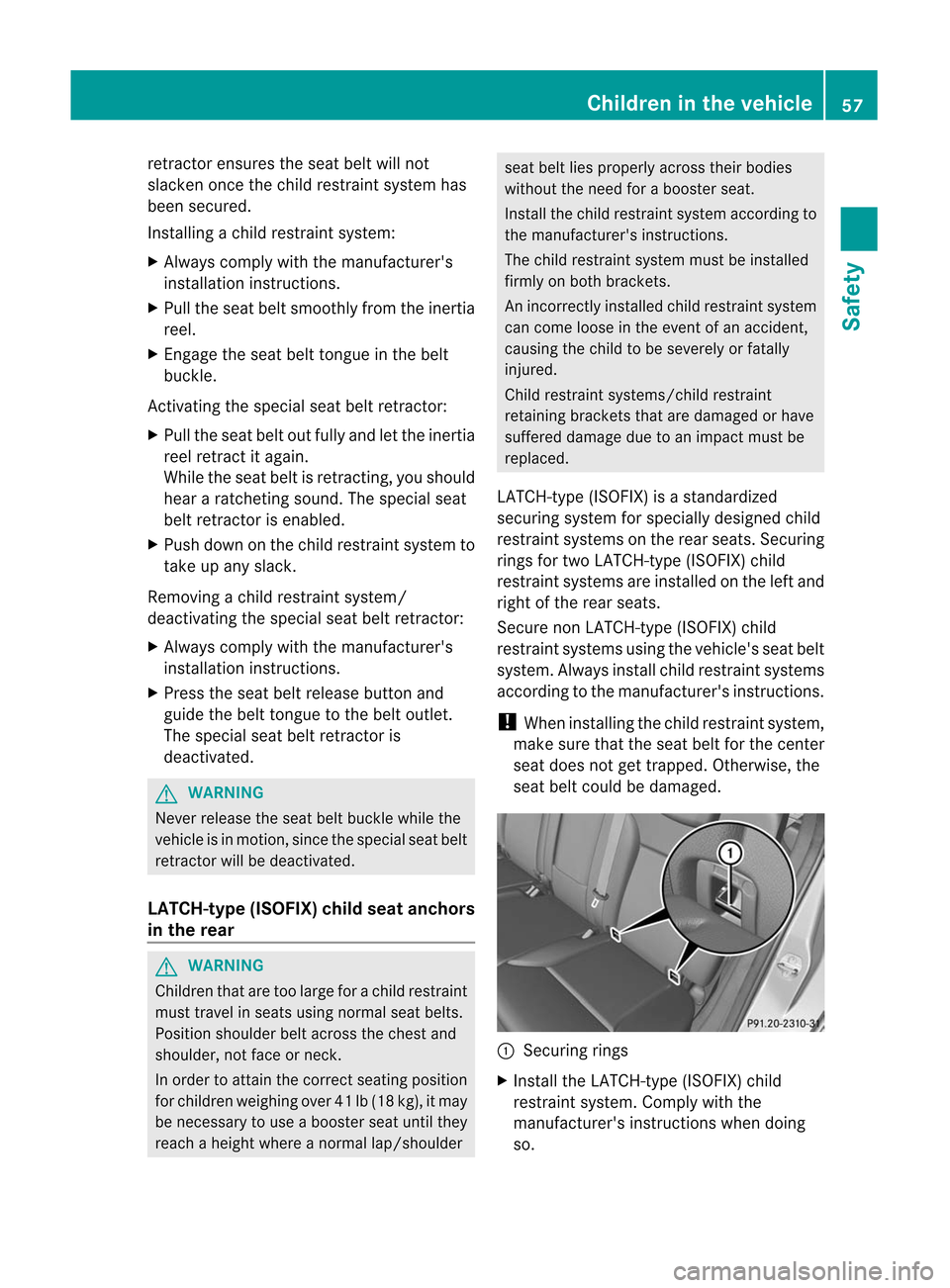
retractor
ensuresthe seat beltw illnot
slack enonc ethe child restraint systemhas
been secured.
In st alling achild restraint system:
X Always complywith themanuf acturer' s
inst allation instruct ions .
X Pull theseat beltsmoo thlyfromt heinertia
reel.
X Engage theseat belttongue inthe belt
buckle.
Act ivating thespecial seatbeltretract or:
X Pull theseat beltoutfully andletthe inertia
reel retract itagain.
While theseat beltisretract ing,youshould
hear aratchet ingsound. Thespecial seat
belt retract orisenabled.
X Push down onthe child restraint systemto
take upany slack.
Removing achild restraint system/
deactivating thespecial seatbeltretract or:
X Always comply withthemanufacturer's
installation instructions.
X Press theseat beltrelease buttonand
guide thebelt tongue tothe belt outlet.
The special seatbeltretract oris
deactivated. G
WARNING Never
release theseat beltbuckle whilethe
vehicle isin motion, sincethespecial seatbelt
retract orwill bedeactivated.
LATCH-type (ISOFIX)child seatanchors
in the rear G
WARNING Children
thataretoo large forachild restraint
must travel inseats usingnormal seatbelts.
Position shoulder beltacross thechest and
shoulder, notface orneck .
In order toattain thecorrect seating position
for children weighing over41lb(18 kg), itmay
be necessary touse abooster seatuntil they
reach aheight whereanormal lap/should er seat
beltliesproperly acrosstheirbodies
without theneed forabooster seat.
Inst allthe child restraint systemaccording to
the manufacturer's instructions.
The child restraint systemmustbeinstalled
firmly onboth brackets.
An incorrec tlyinstalled childrestraint system
can come looseinthe event ofan accident,
causing thechild tobe severely orfatally
injured.
Child restraint systems/child restraint
retaining bracketsthataredamaged orhave
suffered damageduetoan impact mustbe
replaced.
LATCH-t ype(ISOFIX) isastandardized
securing systemforspecially designed child
restraint systemsonthe rear seats. Securing
rings fortwo LATCH-t ype(ISOFIX) child
restraint systemsareinstalled onthe left and
right ofthe rear seats.
Secure nonLATCH-t ype(ISOFIX) child
restraint systemsusingthevehicle's seatbelt
system. Alwaysinstallchildrestraint systems
according tothe manufacturer's instructions.
! When installing thechild restraint system,
make surethattheseat beltforthe cent er
seat does notgettrapped. Otherwise, the
seat beltcould bedamaged. :
Securing rings
X Inst allthe LATCH-t ype(ISOFIX) child
restraint system.Complywiththe
manufacturer's instructionswhen doing
so. Children
inthe vehicl e
57Safety Z
Page 60 of 396
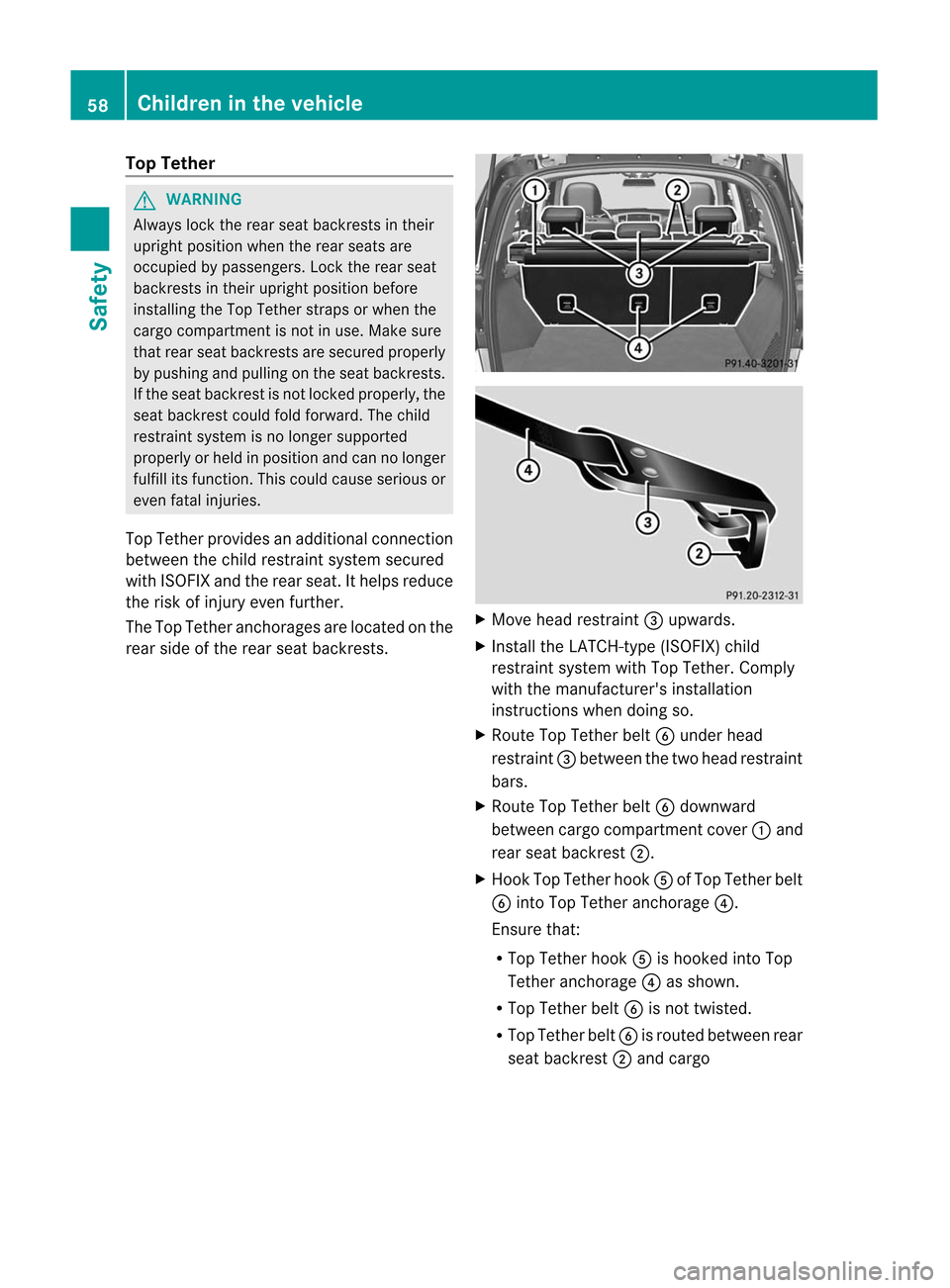
Top
Teth er G
WA
RNING Alw
ayslo ck the rearseat backr estsintheir
upright position whentherear seats are
occupied bypassengers .Lock therear seat
backrest sin their upright position before
installing theTop Tether strapsorwhen the
cargo compartm entisnot inuse. Make sure
that rear seat backrest saresecure dprope rly
by push ingand pulling onthe seat backrests.
If the seat backrest isnot locked properly,the
seat backrest couldfoldforwa rd.The child
restrai ntsystem isno longer supported
prope rlyorheld inposi tion andcannolonger
fulfi llits function. Thiscould causeserio usor
even fatalinjurie s.
Top Tether providesan add itiona lconnection
betwe enthe child restrai ntsystem secured
with ISOFIX andtherear seat. Ithelp sredu ce
the risk ofinjury evenfurther.
The Top Tether anchora gesarelocated onthe
rear side ofthe rear seat backrests. X
Move headrestrai nt= upw ards.
X Install theLATCH-type (ISOFIX)child
restrai ntsystem withTopTether. Comply
with themanufa cturer's installation
instructions whendoing so.
X Rou teTop Tether beltB under head
restrai nt= betwe enthe two head restrai nt
bars.
X Rou teTop Tether beltB dow nward
betwe encargo compartment cover:and
rear seat backrest ;.
X Hook TopTether hookAofTop Tether belt
B into TopTether anchora ge?.
Ensure that:
R Top Tether hookAishooked intoTop
Tether anchora ge? asshow n.
R Top Tether beltB isnot twisted.
R Top Tether beltB isrouted betweenrear
seat backrest ;and cargo 58
Chil
dren inthe vehi cleSafety
Page 61 of 396
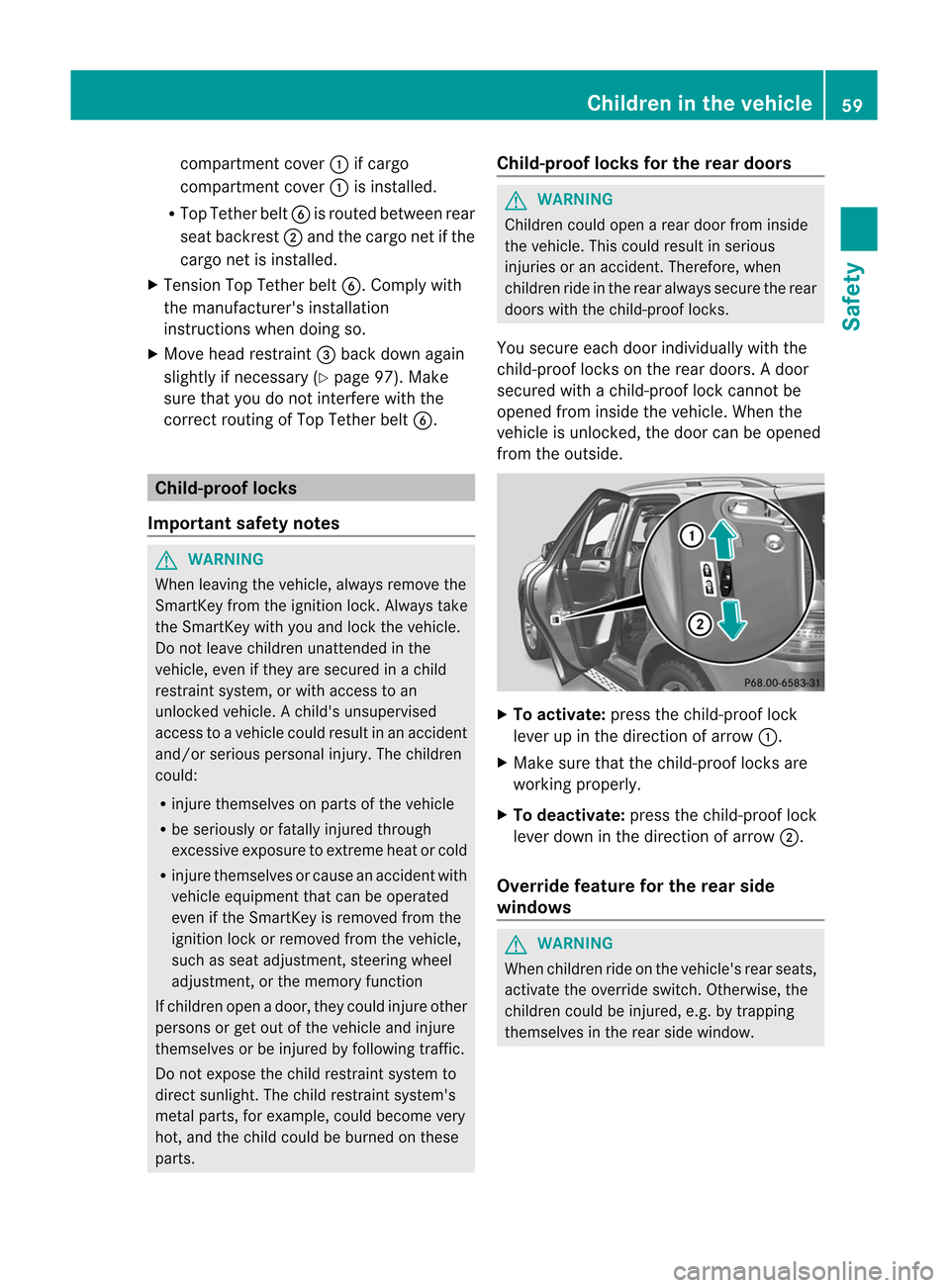
comp
artme ntcove r: ifcarg o
comp artme ntcove r: isinsta lled.
R Top Teth erbel tB isrou ted betw eenrear
sea tback rest; and thecar gonetift he
cargo netisinstalled.
X Tension TopTether beltB.C omply with
the manufacturer 'sinstallation
instr uctions whendoing so.
X Move headrestraint=back down again
slightly ifnecessary (Ypage 97).Make
sure thatyoudonot inter ferewith the
correc trouting ofTop Tether beltB. Child-pr
ooflocks
Import antsafety notes G
WARNIN
G When
leaving thevehicle, alwaysremove the
Smart Keyfrom theignition lock.Always take
the Smart Keywith youand lock thevehicle.
Do not leave children unattendedinthe
vehicle, evenifthey aresecured inachild
restraint system,orwith access toan
unlocked vehicle.Achild's unsupervised
access toavehicle couldresult inan accident
and/or serious personal injury.Thechildren
could:
R injure themselves onparts ofthe vehicle
R be seriously orfatally injured through
excessive exposuretoextrem eheat orcold
R injure themselves orcause anaccident with
vehicle equipment thatcanbeoperated
even ifthe SmartKey isremoved fromthe
ignition lockorremoved fromthevehicle,
such asseat adjustment ,steering wheel
adjustment ,or the memory function
If children openadoor, theycould injure other
persons orget out ofthe vehicle andinjure
themselves orbe injured byfollowing traffic.
Do not expose thechild restraint systemto
direct sunlight. Thechild restraint system's
metal parts, forexample, couldbecome very
hot, andthechild could beburned onthese
parts. Child-proof
locksforthe rear doors G
WARNING Children
couldopenarear door from inside
the vehicle. Thiscould result inserious
injuries oran accident. Therefore, when
children rideinthe rear alwa yssecure therear
doors withthechild-proof locks.
You secure eachdoorindividua llywith the
child-proof locksonthe rear doors. Adoor
secured withachild-proof lockcann otbe
opened frominside thevehicle. Whenthe
vehicle isunlocked, thedoor canbeopened
from theoutside. X
To activat e:press thechild-proof lock
lever upinthe direction ofarrow :.
X Make surethatthechild-proof locksare
working properly.
X To deactivat e:press thechild-proof lock
lever down inthe direction ofarrow ;.
Overrid efeatu refor the rear side
windows G
WARNIN
G When
children rideonthe vehicle's rearseats,
activate theoverride switch.Otherwise, the
children couldbeinjured, e.g.bytrapping
themselves inthe rear side window. Children
inthe vehicle
59Safety Z
Page 68 of 396
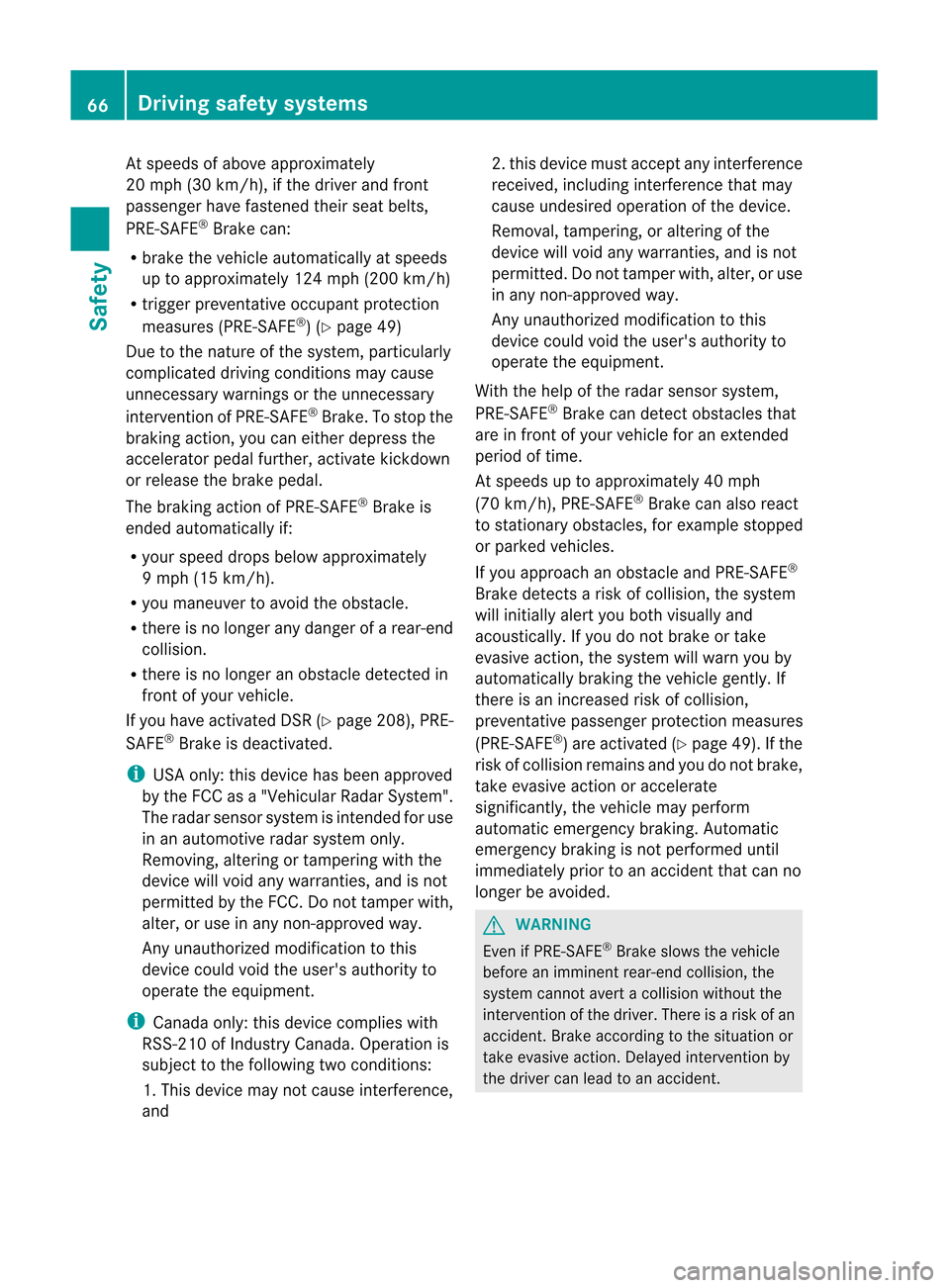
At
spee ds ofabove appro xima tely
20 mph (30km/h) ,if the driver and front
pa sse nge rhave fastened their seat belts,
PRE -SAF E®
Br ake can:
R brak eth eveh icle auto maticall yat spee ds
up toappro ximately12 4mph (200km /h)
R trigger preventat ive occupan tpro tection
meas ures(PRE-SAF E®
)(Y page 49)
Due tothenat ure ofthesyst em, particular ly
co mplic ateddriv ingcond ition sm aycaus e
unn ecessar ywarn ingsor theu nnece ssary
inte rventio nof PR E-SAFE ®
Bra ke. Tostop the
bra king action, youcan either depre ssthe
acce lera tor pedalfu rthe r,acti vate kickd own
or release the brakepedal.
The braking actionofPR E-SAFE ®
Bra keis
end edautoma tically if:
R yo ur spe eddro psbelow ap pro xima tely
9 mph (15km/h) .
R yo uma neu ver toavoid the obsta cle.
R ther eis no longe rany dange rofarea r-end
colli sion.
R there isno longer anobstacl edetected in
front ofyou rvehicl e.
If you have activa tedDSR (Ypag e208), PRE-
SAFE ®
Brake isdea ctivated. i
USA
only:this device hasbeen approved
by the FCC asa"Vehicula rRadar System".
The radar sensor syst emisint ended foruse
in an auto motiveradar systemonly.
Remo ving,alte ringor tam peringwithth e
devi cewill void anywarr anties, and isno t
perm itted bytheFCC. Donottamper with,
alte r,or use inany non-appro vedway.
An yunaut horizedmod ificatio ntothis
device couldvoidtheuser's authority to
operate theequipment. i
Canada
only:thisdevice complies with
RSS-2 10ofIndustr yCanada. Operation is
subject tothe following twocondit ions:
1. This device maynotcause interferenc e,
and 2.
this device mustaccept anyinterf erence
received, includinginterference thatmay
cause undesired operationofthe device.
Removal, tampering, oraltering ofthe
device willvoid anywarranties, andisnot
permitt ed.Donot tamper with,alter, oruse
in any non- approved way.
Any unauthorized modificationtothis
device couldvoidtheuser's authority to
operate theequipment.
With thehelp ofthe radar sensor system,
PRE-S AFE®
Brake candetect obstacles that
are infront ofyour vehicle foranexten ded
period oftime.
At speeds uptoapproximately 40mph
(70 km/ h),PRE-S AFE®
Brake canalso react
to station aryobstacles, forexample stopped
or parked vehicles.
If you approach anobstacle andPRE-S AFE®
Brake detect sa risk ofcollision, thesystem
will initially alertyouboth visually and
acoustically. Ifyou donot brake ortake
evasive action,thesystem willwarn youby
automatically brakingthevehicle gently.If
there isan increased riskofcollision,
prevent ativepassenger protectionmeasures
(PRE-SA FE®
)are activated (Ypage 49).Ifthe
risk ofcollision remainsandyoudonot brake,
take evasive actionoraccelerate
significant ly,the vehicle mayperform
automatic emergencybraking. Automatic
emergenc ybraking isnot performed until
immediately priortoan accident thatcanno
longer beavoided. G
WARNIN
G Even
ifPRE-S AFE®
Brake slowsthevehicle
before animminent rear-endcollision, the
system cannotavert acollision withoutthe
interv ention ofthe driver. Thereisarisk ofan
accident .Brake according tothe situation or
take evasive action.Delayed intervention by
the driver canlead toan accident . 66
Driving
safetysystemsSafety
Page 90 of 396
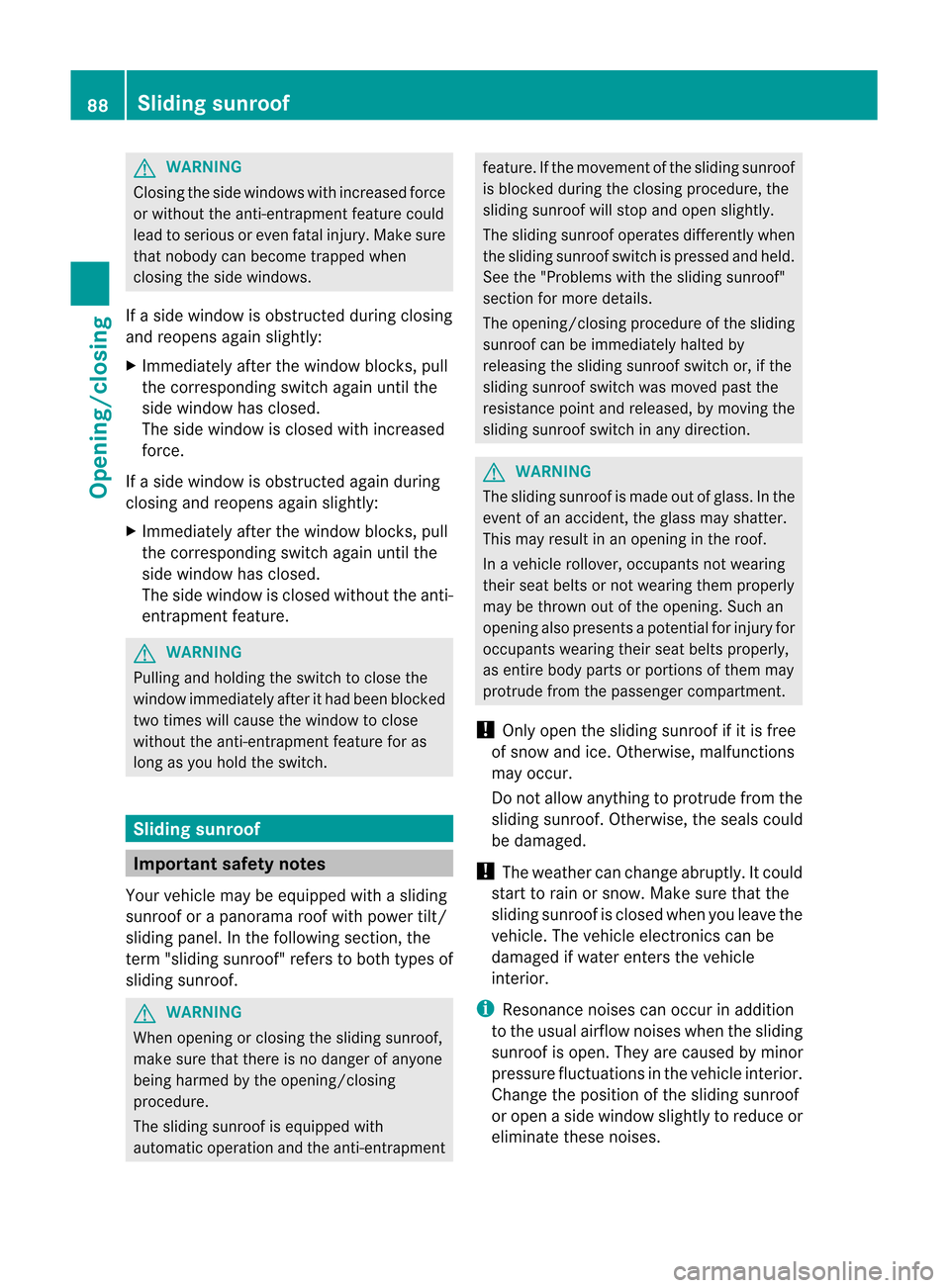
G
WARNING Clo
sing theside windo wswith increas edforce
or witho utthe anti-entrapme ntfeatu recoul d
lea dto serio usoreven fatalinjury .Make sure
th at nobody canbecome trapped when
clo singth eside windows.
If aside windowisobst ructeddurin gclo sing
and reopen sagain slightly:
X Imm ediat elyafterthewind owbloc ks,pull
th ecor respon dingswit chagain untilth e
side windowhas closed.
The side windowisclo sed with increas ed
for ce.
If aside windowisobst ructedagain during
clo singand reopen sagain slightly:
X Imm ediat elyafterthewind owbloc ks,pull
th ecor respon dingswit chagain untilth e
side windowhas closed.
The side wind owisclo sed with outtheant i-
ent rapm entfeat ure. G
WAR
NING Pullin
gand holdi ngtheswit chtoclo sethe
wind owimm ediat elyafterithad been blocked
two timeswill caus eth ewind owtoclo se
with outtheant i-entrapm entfeat ure foras
lon gas you hold theswit ch. Slid
ingsunroof Imp
ortant safety notes
Your vehicle may beequippe dwith aslidin g
sun rooforapanorama roofwith power tilt/
sliding panel.Inthe following section, the
term "sliding sunroof"refer sto both types of
sliding sunroof . G
WARN
ING When
openin gor closin gthe sliding sunroof ,
make surethatthereis no danger ofanyone
being harmed bythe openin g/closing
procedur e.
The sliding sunroof isequipped with
automatic operationandtheanti- entrapmen t feature.
Ifthe movem entofthe sliding sunroof
is block edduring theclosin gprocedu re,the
slid ing sunroof willstop andopen slightly.
The sliding sunroof operatesdiffere ntlywhen
the slidingsunroof switch ispresse dand held .
See the"Prob lemswiththesliding sunroof"
section formore details.
The opening/cl osingprocedu reofthe sliding
sunroof canbeimmed iatelyhal ted by
relea singthesliding sunroof switch or,ifthe
slid ing sunroof switch was moved pastthe
resista ncepoint andrelea sed,bymoving the
slid ing sunroof switch inany directio n. G
WARNING The
slidingsunroof ismade outofgla ss. Inthe
event ofan accide nt,the glassmay shatter.
This may resul tina no penin gin the roof.
In avehicle rollover, occupants notwearing
their seatbelts ornot wearing themproperly
may bethrown outofthe openin g.Such an
openin galso presen tsapoten tialforinjury for
occ upants wearing theirseatbelts properly,
as ent irebody parts orportion sof them may
protr udefrom thepassenger compartment.
! Only open thesliding sunroof ifit is free
of snow andice.Other wise, malfunc tions
may occur.
Do not allow anythin gto protr udefrom the
sliding sunroof .Othe rwise, the sealscou ld
be dama ged.
! Thewe ath ercan change abruptl y.Itcou ld
sta rtto rain or sno w.Ma kesure tha tthe
sl id ing sunroo fisclosed whenyouleave the
vehicle. Thevehicle electronics canbe
damage difwater enters thevehicle
interior. i
Resonance
noisescanoccur inaddition
to the usua lairflow noiseswhenthesliding
sunroof isopen. Theyarecaused byminor
pressure fluctuations inthe vehicle interior.
Change theposition ofthe sliding sunroof
or open aside window slightlytoreduce or
eliminate thesenoises. 88
Sliding
sunroofOpening/closing
Page 96 of 396
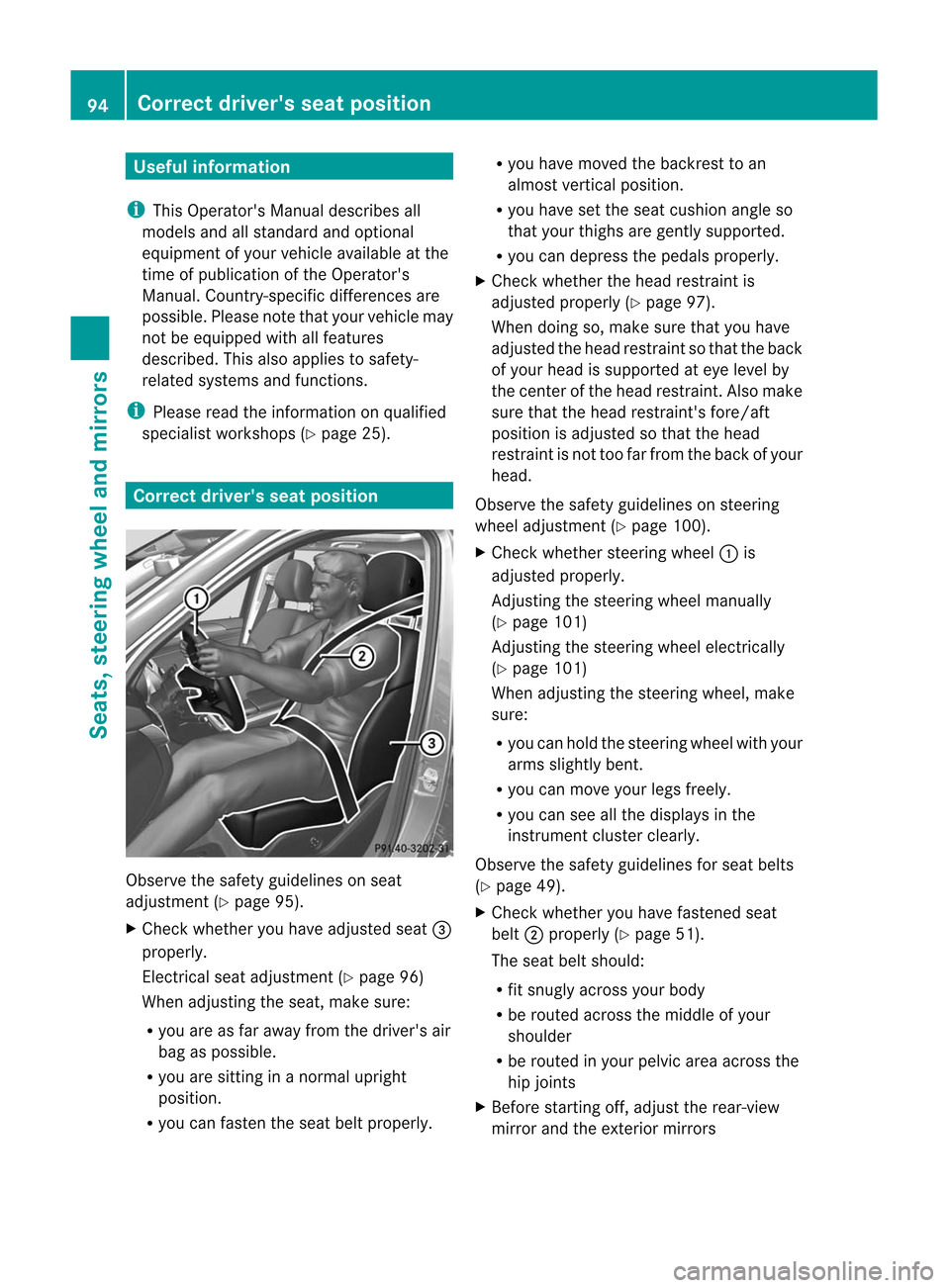
Useful
information
i This
Operat or'sManual describesall
models andallstan dard andoption al
equipment ofyour vehicle available atthe
time ofpublication ofthe Operat or's
Manual. Country-specificdiffer encesare
possible. Pleasenotethat your vehicle may
not beequipped withallfeature s
descr ibed. Thisalso applies tosafet y-
related systemsand func tions. i
Please
readtheinfor mation onqualified
specialist workshops(Ypage 25). Correct
driver's seatposition Observ
ethe safet yguidelines onseat
adjust ment(Ypage 95).
X Check whether youhave adjust edseat =
properly.
Elec tricalseat adjust ment(Ypage 96)
When adjustingthe seat, make sure:
R you areasfar away fromthedriver' sair
bag aspossible.
R you aresitting inanor mal upright
position .
R you can faste nthe seat beltproperly. R
you have moved thebackrest toan
almost vertical position.
R you have setthe seat cushion angleso
that your thighs aregently supported.
R you can depress thepedals properly.
X Check whether thehead restraint is
adjusted properly(Ypage 97).
When doingso,make surethatyouhave
adjusted thehead restraint sothat theback
of your head issupported ateye level by
the cent erofthe head restraint .Also mak e
sure thatthehead restraint 'sfor e/af t
posit ionisadjust edsothat thehead
rest raint isnot too farfromt heback ofyour
head.
Observe thesafety guidelinesonsteering
wheel adjustment (Ypage 100).
X Check whether steeringwheel:is
adjusted properly.
Adjustin gthe steering wheelmanually
(Y page 101)
Adjustin gthe steering wheelelectrically
(Y page 101)
When adjusting thesteering wheel,make
sure:
R you can hold thesteering wheelwithyour
arms slightly bent.
R you can move yourlegsfreely.
R you can seeallthe displa ysinthe
instrumen tcluste rclearly.
Obser vethe safet yguideline sfor seat belts
(Y page 49).
X Check whetheryou have fastened seat
belt ;proper ly(Y page 51).
The seat beltshould:
R fit snug lyacro ssyour body
R be rout edacro ssthe middle ofyour
shoulder
R be rout edinyour pelvic areaacrossthe
hip joints
X Bef ore start ing off,adjust therear- view
mirr orand theexterior mirrors 94
Corr
ectdriver' sseat posit ionSeats, steering wheel and mirrors